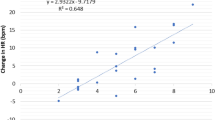Abstract
There are few systematic investigations of the potential benefits of incidental touch as it occurs in medical health care settings. In the present laboratory study 60 college students participated in two testing sessions 1 month apart. These sessions involved counterbalanced conditions of baseline, pulse palpation (touch), cold pressor test (stressor), and combined cold pressor/pulse palpation. Heart rate and systolic and diastolic blood pressure were measured during each condition. Subjective pain ratings were recorded during stress conditions. Significant decreases in cardiovascular measures and pain ratings were associated with physical contact. However, these changes were small and individual responses to physical contact were not stable over time. Physical contact produces a small but significant decrease in cardiovascular variables and the experience of pain. However, the tendency to show a cardiovascular response to touch does not represent a stable trait for individuals in the laboratory setting.
Similar content being viewed by others
References
Crick, J. E., and Brennan, R. L. (1983).GENOVA: A Generalized Analysis of Variance System, Version 2.1, American College Testing Program Technical Bulletin No. 43.
Cronbach, L. J., Gleser, G. C., Nanda, H., and Rajaratnam, N. (1972).The Dependability of Behavioral Measurements: Theory of Generalizability for Scores and Profiles, Wiley, New York.
Drescher, V. M., Gantt, W. H., and Whitehead, W. E. (1980). Heart rate response to touch.Psychosom. Med. 42: 559–565.
Drescher, V. M., Hayhurst, V., Whitehead, W. E., and Joseph, J. A. (1982). The effects of tactile stimulation on pulse rate and blood pressure.Biol. Psychiat. 17: 1347–1352.
Drescher, V. M., Whitehead, W. E., Morrill-Corbin, E. D., and Cataldo, M. F. (1985). Physiological and subjective reactions to being touched.Psychophysiology 22: 96–100.
Gantt, W. H., Newton, J. E. O., Royer, F. L., and Stephens, J. H. (1966). Effect of person.Condition. Reflex 1: 18–35.
Goodykoontz, L. (1979). Touch: Attitude and practice.Nurs. Forum 18: 4–17.
Kirk, R. (1982).Experimental Design, 2nd ed. Brooks/Cole, CA.
Lynch, J. J. (1978). The simple act of touching.Nursing 8: 32–36.
Lynch, J. J., and Gantt, W. H. (1968). The heart rate component of the social reflex in dogs: The conditional effects of petting and person.Condition. Reflex 3: 69–80.
Lynch, J. J., and McCarthy, J. F. (1969). Social responding in dogs: Heart rate changes to a person.Psychophysiology 5: 389–393.
Lynch, J. J., Thomas, S. A., Mills, M. E., Malinow, K., and Katcher, A. H. (1974). The effects of human contact on cardiac arrhythmia in coronary care patients.J. Nerv. Ment. Dis. 158: 88–99.
Lynch, J. J., Thomas, S. A., Long, J. M., Malinow, K. L., Chickadonz, G., and Katcher, A. H. (1980). Human speech and blood pressure.J. Nerv. Ment. Dis. 168: 526–534.
Manuck, S. B., and Schaefer, D. C. (1978). Stability of individual differences in cardiovascular reactivity.Physiol. Behav. 21: 675–678.
McKinney, M. E., Miner, M. H., Ruddel, H., McIlvain, H. E., Witte, H., Buell, J. C., Eliot, R. S., and Grant, L. B. (1985). The standardized mental stress test protocol: Test-retest reliability and comparison with ambulatory blood pressure monitoring.Psychophysiology 22: 453–463.
Mills, M. E., Thomas, S. A., Lynch, J. J., and Katcher, A. H. (1976). Effect of pulse palpation on cardiac arrhythmia in coronary care patients.Nurs. Res. 25: 378–382.
Owens, O., and Gantt, W. H. (1950). Does the presence of person act on cardiac rate of the dog as unconditional stimulus?Am. J. Physiol. 163: 740.
Pavlov, I. P. (1932). Reply of a physiologist to psychologists.Psychol. Rev. 39: 2.
Pratt, J. W., and Mason, A. (1984). The meaning of touch in care practice.Soc. Sci. Med. 18: 1081–1088.
Rose, S. (1979).A Touch of Sensitivity, Films Inc., Wilmette, IL.
Spitz, R. A. (1945). Hospitalism: An inquiry into the genesis of psychiatric conditions in early childhood.Psychoanal. Study Child 1: 53–74.
Turner, J. R., Carroll, D., Sims, J., Hewitt, J. K., and Kelly, K. A. (1986). Temporal and inter-task consistency of heart rate reactivity during active psychological challenge: A twin study.Physiol. Behav. 38: 641–644.
Yelderman, M., and Ream, A. D. (1979). Indirect measurement of mean blood pressure in the anesthetized patients.Anesthesiology 50: 253–256.
Author information
Authors and Affiliations
Rights and permissions
About this article
Cite this article
Fishman, E., Turkheimer, E. & DeGood, D.E. Touch relieves stress and pain. J Behav Med 18, 69–79 (1995). https://doi.org/10.1007/BF01857706
Accepted:
Issue Date:
DOI: https://doi.org/10.1007/BF01857706




